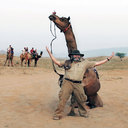0 Likes
The Spitakavor Monastery complex is located in the Vayots Dzor Province, 7kms north of the Vernashen village on the slopes of Teksar mountain. It is about 8.4 kilometres from the University of Gladzor (Museum) and Tanahat Monastery and about 6 kilometres to the Proshaberd fortress.
The Spitakavor Monastery complex consists of a church, a vestibule, a bell-tower and surrounded by fort-walls. The buildings are made of white shaved felzit. The Spitakavor Monastery was built by two princes from the Proshian dynasty during the Zakarid Armenia period. The construction of the church began by Prince Eachi (died in 1318) and completed in 1321 by his son Prince Amir Hasan II. Between 1321 and 1330, the narthex was built, and in 1330 Hovhannes Proshian and his wife, Tadzna, added a three-story bell-tower to the western wall of narthex. In ancient times it was one of the most significant cultural, educational and spiritual centers in Vayots Dzor
Under the monastery walls there is a grave of Armenian Great General, military leader and political thinker Garegin Nzhdeh. Annually on June 17 Armenians across the world conduct a pilgrimage to the monastery's graveyard.
...





Modern civilization began right here in the Tigris-Euphrates river valley. Also known as the Fertile Crescent or Mesopotamia, this is the place where, six thousand years ago, agriculture, writing and mathematics were brought into widespread use.The term "Middle East" comes from the British navy, which used it to describe the countries on the trade route from Europe to India and China. Everything from Afghanistan to Morocco may possibly be classified as "middle eastern", depending on whom you ask -- and when.Only a partial list of past Empires in the middle eastern territory includes Sumeria, Babylonia, Persia, the Ottoman Empire and the Roman Empire!When northern Europe was still lurking about in slimy cold stone castles playing chess, the Middle East was enjoying the flowers of poetry, luxurious craftsmanship, music and literature. In fact, the Renaissance in Europe was partly inspired by stories brought back from the middle east by travelers along the trade route.Strategic location, religious history and the world's largest supply of crude oil have kept the Middle East at the center of world activity for centuries. The saga continues.Text by Steve Smith.